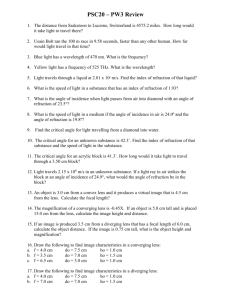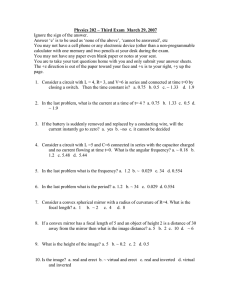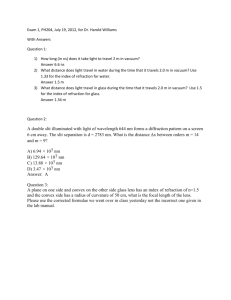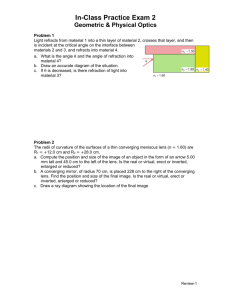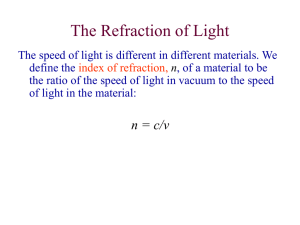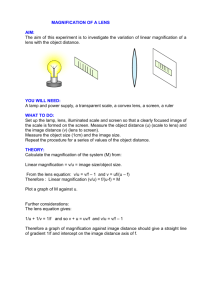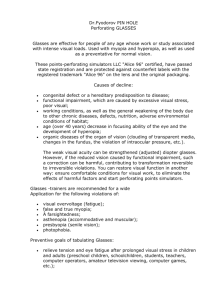exam3
advertisement
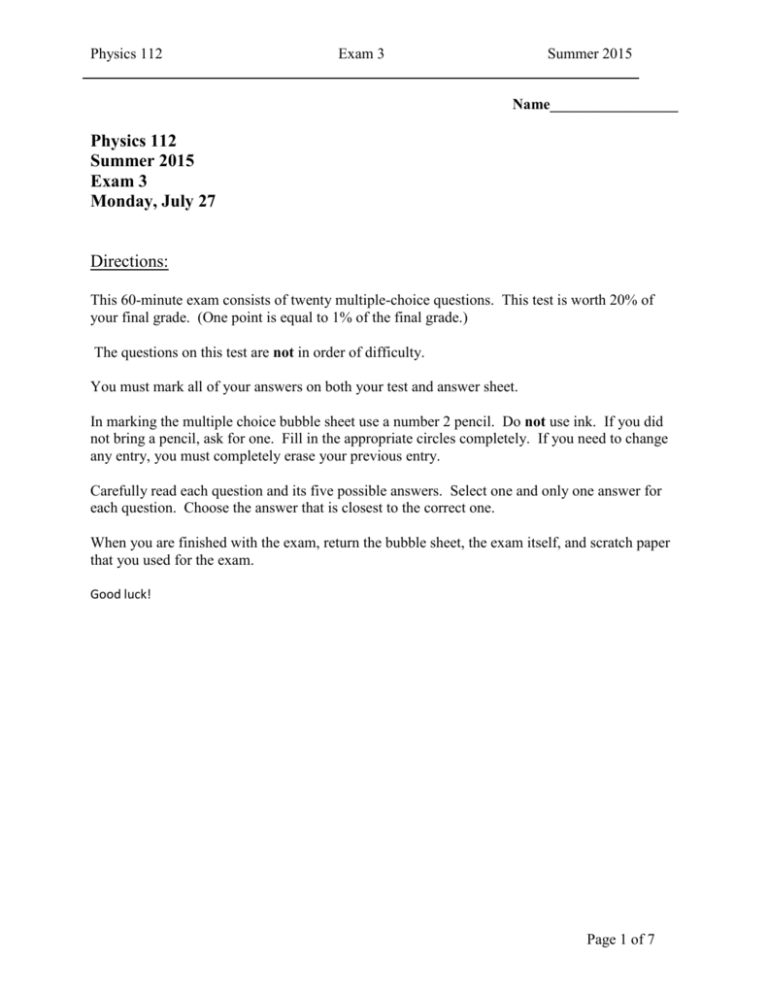
Physics 112 Exam 3 Summer 2015 Name_________________ Physics 112 Summer 2015 Exam 3 Monday, July 27 Directions: This 60-minute exam consists of twenty multiple-choice questions. This test is worth 20% of your final grade. (One point is equal to 1% of the final grade.) The questions on this test are not in order of difficulty. You must mark all of your answers on both your test and answer sheet. In marking the multiple choice bubble sheet use a number 2 pencil. Do not use ink. If you did not bring a pencil, ask for one. Fill in the appropriate circles completely. If you need to change any entry, you must completely erase your previous entry. Carefully read each question and its five possible answers. Select one and only one answer for each question. Choose the answer that is closest to the correct one. When you are finished with the exam, return the bubble sheet, the exam itself, and scratch paper that you used for the exam. Good luck! Page 1 of 7 Physics 112 Exam 3 Summer 2015 41. A beam of light in air strikes a slab of glass (n 1.50) at a 30.0° angle to the vertical. What is the angle of refraction? A. B. C. D. E. 30.0° 25.7° 19.5° 15.0° 10.3° 42. A diver shines a flashlight upward from beneath the water at a 60.0° angle to the vertical. Index of refraction water is 1.33. At what angle does the light leave the water? A. B. C. D. E. 60° 50° 40° 30° It does not leave the water 43. The speed of light in a certain substance is 89% of its value in water. What is the index of refraction of this substance? A. B. C. D. E. 1.00 1.21 1.49 1.60 3.00 44. Which statement concerning mirrors is wrong? A. B. C. D. E. Real image is always inverted Inverted image is always real Virtual image is always erect Erected image is always virtual Real and virtual images could be erect or inverted Page 2 of 7 Physics 112 Exam 3 Summer 2015 45. Which statement concerning lenses is wrong? A. B. C. D. E. Real image is always inverted Inverted image is always real Virtual image is always erect Erected image is always virtual Real and virtual images could be erect or inverted 46. A 4.0-cm-tall object is placed 10 cm in front of a spherical mirror. It is desired to produce a virtual image 6.0 cm tall. What is the focal length of the mirror? A. B. C. D. E. 30 cm 25 cm 20 cm 15 cm 10 cm 47. Find magnification, if a real image is located at the same distance from a mirror as the object? A. B. C. D. E. 1 -1 2 -2 It is impossible to have this kind of image 48. Parallel light rays are directed from air into a double convex glass lens. These rays will converge at: A. B. C. D. E. Focal point Two focal distances from the lens One half of the focal from the lens At the center of the lens On the surface of the lens Page 3 of 7 Physics 112 Exam 3 Summer 2015 49. Monochromatic light falls on two very narrow slits. Successive fringes on a screen 5.00 m away are 6.5 cm apart near the center of the pattern. What is the distance between the slits if the wavelength of the light is 650 nm? A. B. C. D. E. 500 µm 100 µm 50 µm 25 µm 5.0 µm 50. Monochromatic light falls on a slit that is 2.60 10 3 mm wide. If the angle between the first dark fringes on either side of the central maximum is 30.0° (dark fringe on one side to dark fringe on another side), what is the wavelength of the light used? A) B) C) D) E) 450 nm 511 nm 585 nm 627 nm 673 nm 51. The separation between adjacent maxima in a double-slit interference pattern using monochromatic light is A) B) C) D) E) Greatest for red light Greatest for green light Greatest for blue light The same for all colors of light It is smallest for green light . 52. A 3500 lines/cm grating produces a third-order fringe at a 28.0° angle. What wavelength of light is being used? A) B) C) D) E) 421 nm 447 nm 502 nm 631 nm 680 nm Page 4 of 7 Physics 112 Exam 3 Summer 2015 53. An important reason for using a very large diameter objective in an astronomical telescope is A) B) C) D) E) To increase the magnification To increase the resolution To form a virtual image To form a real image To increase the width of the field of view 54. A lens appears greenish yellow ( 570 nm is strongest) when white light reflects from it. What minimum thickness of coating n=1.25 is used on such a glass (n 1.52) lens? A) B) C) D) E) 570 nm 512 nm 450 nm 321 nm 228 nm 55. What is Brewster’s angle for a diamond submerged in water if the light is hitting the diamond (n 2.42 ) while traveling in the water (n =1.33)? A) B) C) D) E) 33° 41° 52° 61° 72° 56. What kinds of image observe people wearing glasses? A) B) C) D) E) Always real Always virtual Real if glasses’ power is positive, and virtual if glasses’ power is negative Real if glasses’ power is negative, and virtual if glasses’ power is positive It could be real and virtual for any power of glasses Page 5 of 7 Physics 112 Exam 3 Summer 2015 57. A person has a far point of 14 cm. What power glasses would correct this vision if the glasses were placed 2.0 cm from the eye? A) B) C) D) E) +2.0 -2.0 -4.6 -6.5 -8.3 58. A nearsighted person wears contact lenses whose power is -5.0D. What is the person's far point? A) B) C) D) E) 5 cm 10 cm 20 cm 50 cm 1.0 m 59. A small insect is placed 5.0 cm from a 6.00-cm-focal -length lens. Calculate the angular magnification. A) B) C) D) E) 1.2 2.4 4.1 5.0 6.0 60. An astronomical telescope has an objective with focal length 85 cm and a 35-D eyepiece. What is the total magnification? A) B) C) D) E) -15 -20 -30 -35 -41 Page 6 of 7 Physics 112 Exam 3 Summer 2015 Record Sheet You may fill in this sheet with your choices, detach it and take it with you after the exam for comparison with the posted answers 41 51 42 52 43 53 44 54 45 55 46 56 47 57 48 58 49 59 50 60 Page 7 of 7
